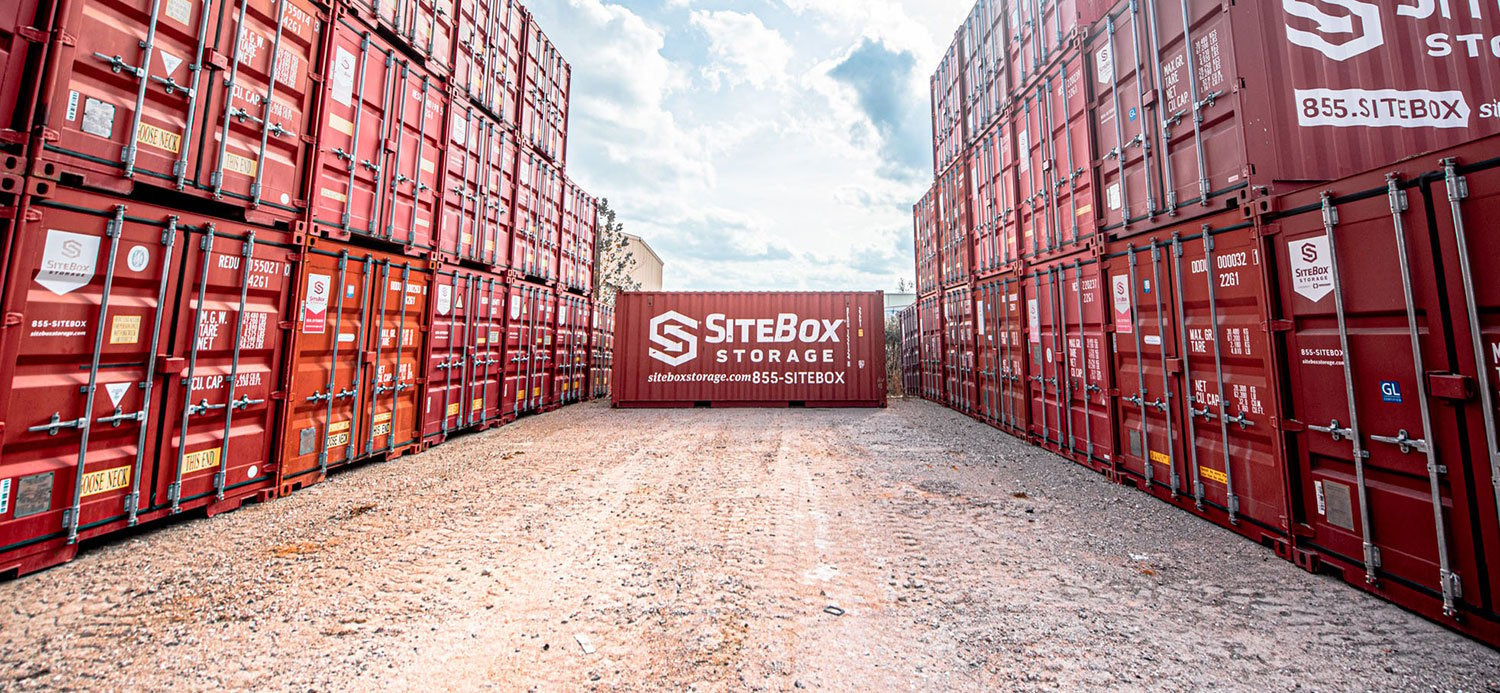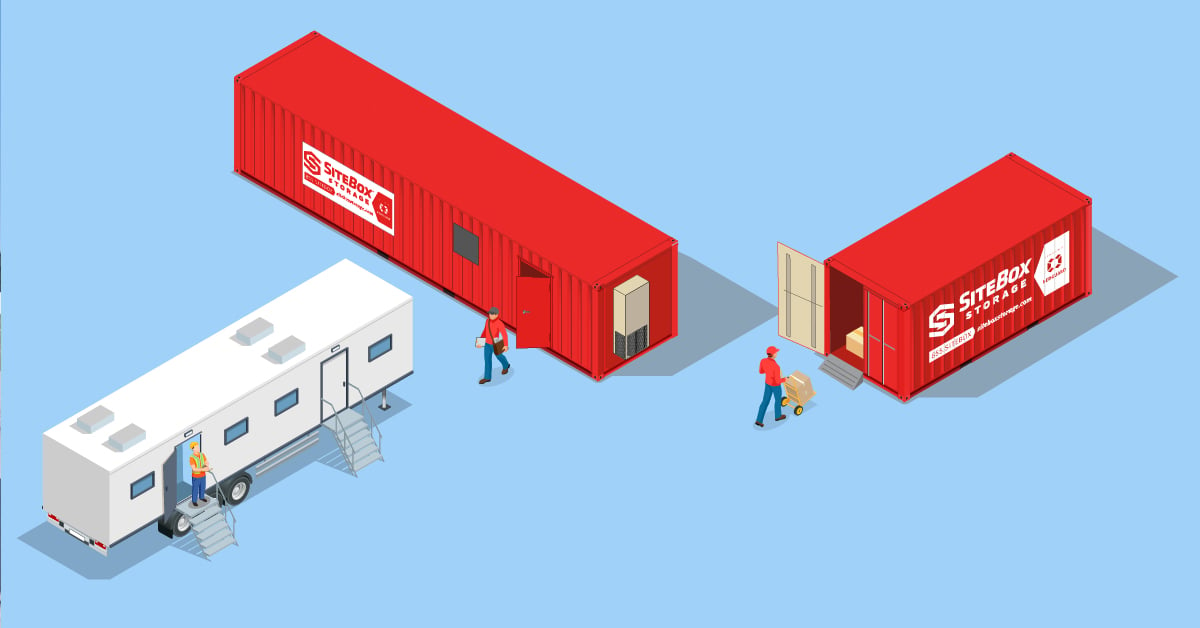What Is An Onsite Storage Container?

Not long ago, most people barely gave cargo containers a second thought. Everyone knew goods arrived from overseas in those big metal boxes on shipping barges, but that was about it.
These rugged containers have become surprisingly popular because they're built to last. Our company started as "ABox4U," renting containers for temporary storage at construction sites and refineries. After our parent company became RedGuard in 2005, the container rental side evolved into SiteBox Storage.

Onsite storage containers are typically one-trip shipping containers manufactured overseas, used once to ship goods to the U.S., then inspected for their second life. Built from heavy gauge steel and engineered to survive ocean crossings, they're water-resistant, keep rodents out, and feature lockable doors at one or both ends. You'll find them in 10-, 20-, and 40-foot lengths, all 8 feet wide and 8.5 feet tall on the outside.
Types of Onsite Storage Containers
When shopping for storage solutions, you'll find more variety than expected. Standard cargo containers remain most popular, but the industry has expanded to meet different needs.
Classic steel shipping containers lead the pack in those standard sizes, they've got the durability and security that made them famous in logistics. Modified containers serve customers needing office space alongside storage, with windows, insulation, and electrical hookups added. Some get customized with shelving, climate control, or specialized security depending on what inventory you're protecting.

Refrigerated containers (reefers) serve businesses with temperature-sensitive goods. They're not common for typical construction projects, but essential for certain industries.
Benefits of Using Cargo Containers for Storage
Cargo containers are probably the sturdiest option for protecting equipment and supplies. Over 73,000 onsite storage containers are rented in the U.S. annually for good reason.
Security tops the list. Around 64% of people renting containers say security features matter most. These boxes were designed to protect cargo worth millions during ocean transport, so keeping your stuff safe on a job site is well within their capabilities.
Weather protection is another major plus. Rain, snow, wind, these containers handle it all thanks to weatherproof construction.

Accessibility matters too. Unlike driving across town to a storage facility, your container sits right where you need it. Contractors grab supplies without wasting time. Small businesses get extra inventory space without expanding their footprint. Homeowners doing renovations protect furniture from construction dust.
Material and Construction Features
Let's talk about what makes these containers tough. The steel used isn't standard sheet metal, it's heavy gauge corrugated steel built to withstand serious punishment.
The walls, floor, and roof all feature durable steel construction. The corrugated design adds structural strength while keeping weight manageable. Everything's welded together creating a solid, weatherproof box.

Standard shipping containers weigh around 2,350 kilograms empty and hold up to 28,200 kilograms when loaded. The treated steel resists corrosion, helping cargo containers maintain an average lifespan of 27.5 years before needing refurbishment. That's longer than most storage solutions, making them an excellent investment.
Size and Capacity Options
Figuring out which size you need depends on what you're storing. Standardized dimensions mean you know exactly what you're getting.
The 10-foot container works for smaller projects or tight spaces. It's portable and fits where larger containers won't, great for residential projects or small businesses with limited yard space.
Twenty-foot containers hit the sweet spot for many customers, providing substantial storage without taking up too much room. You can fit plenty of equipment and supplies while leaving space for other activities.
The 40-foot container handles major projects. Construction companies and businesses with significant storage needs choose this size for everything from boxed supplies to full-length pipes.

All containers maintain that 8-foot width and 8.5-foot height, making planning easier. You can calculate floor space and cubic footage quickly once you know the length you need.
Security Features and Locks
Security is built into these containers from the start. Heavy steel construction provides a strong deterrent, but there's more.
The lockable swing-out doors use heavy-duty hinges and locking mechanisms. Most containers come with standard lock boxes that protect the padlock from tampering. You can add high-security padlocks or upgrade to advanced systems depending on your needs.

Some customers add alarm systems or door reinforcement. The solid construction makes break-ins difficult without significant noise and time.
The weight works in your favor too. A 20-foot container weighs about 4,800 pounds, while a 40-footer weighs around 8,000 pounds. Nobody's walking off with one, and they're too heavy to easily pry open or tip over.
Delivery and Installation Process
Getting a container to your location requires specialized equipment. You can't hitch one to your pickup truck.
Rental or purchase delivery uses tilt-bed tractor-trailer rigs designed for this job. The driver positions the container where you want it on your property, then levels it for you.
Sometimes terrain or obstacles make perfect placement impossible. Cranes solve that problem. These containers were made to be lifted onto cargo ships, so crane transport is no issue. It costs extra but handles difficult placements.
Before delivery, prepare a level spot. The ground should support the weight without the container sinking. Most customers use gravel or concrete blocks for a stable foundation.
Customization and Modifications
These containers are incredibly adaptable. Once people realized they could do more than store stuff, creativity took over.
Converting containers into office space has become popular. Add windows, insulation, electricity, and climate control for functional workspace at a fraction of traditional construction costs. Some businesses create satellite offices or modular complexes by connecting multiple units.

Shelving and organization systems transform containers into organized warehouse space, maximizing cubic footage and keeping inventory accessible. Custom racks work for lumber, pipes, or parts.
You can also add roll-up doors, extra access points, ventilation, paint, security cameras, or lighting. Modifications are limited mainly by budget and imagination.
Cost and Rental vs Purchase Options
Price varies based on size, condition, location, and whether you're renting or buying.
Rental makes sense for temporary needs like construction projects, seasonal storage, or short-term solutions. You get the container as long as needed without ownership commitment. Pricing depends on location and duration, typically a monthly fee.
Purchasing appeals to customers with ongoing storage needs. Higher upfront cost, but no monthly fees. Used containers cost less than new ones, though both offer excellent durability.
Lease-to-own provides middle ground with monthly payments eventually leading to ownership, spreading out the cost while building toward owning outright.
Get a quote based on your specific needs. Companies like SiteBox Storage can work with your budget to find solutions that make sense.
Common Uses and Applications
These containers serve more purposes than most realize. The global cargo container market grew 8.2% between 2022 and 2024, reflecting their versatility.
Construction sites represent the most common use. Tools, equipment, materials stay secure and organized. Contractors lock up daily knowing their stuff is protected.

Retail businesses use containers for overflow inventory during peak seasons. Rather than cramming stockrooms, they keep extra products steps away out back.
Emergency operations provide secure, weathertight storage for food, medical supplies, and rescue equipment. Organized, accessible supplies make a huge difference when disaster strikes.
Residential customers rent during moves, renovations, or decluttering. Some convert them into workshops, home offices, or storage sheds. Industrial facilities use containers for raw materials to equipment housing.
Maintenance and Care Tips
Containers are low-maintenance, but care extends their impressive lifespan.
Check the roof periodically for standing water or debris. While weatherproof, keeping the roof clear prevents unnecessary wear. Inspect door seals to ensure they're working.
Address rust quickly when noticed. Treatment now prevents bigger problems later. The treated steel resists corrosion, but catching issues early maintains protection.
Keep doors and hinges lubricated for smooth operation and longevity. Clean the interior occasionally, especially if storing materials creating dust or debris.
For customizations like electrical or HVAC systems, follow manufacturer maintenance recommendations. The container is simple, but add-ons need their own care.
Choosing the Right Container for Your Needs
Making the right choice starts with understanding your goals.
How much stuff needs to fit? Measure equipment or supplies and add breathing room. Better to have slightly larger space than play Tetris every time you need something.
How long do you need it? Short-term projects point toward rental. Ongoing needs might justify purchasing.
What security level does your inventory require? Standard containers offer excellent protection, but high-value items might need additional features.
Where will it sit? Ensure adequate space and access for delivery. Local regulations sometimes restrict placement, so check first.
Does your budget allow customization? Basic containers work great, but modifications make them more functional for specific situations.
Working with experienced teams helps answer these questions. Storage solution specialists guide you toward the right choice based on what works in different situations.
Why Steel Containers Outperform Other Options
You've got other temporary storage choices, trailers, pods, mobile units. Most are built with sheet metal over wooden or steel frameworks. They're decent, but don't measure up to cargo containers.
Those options struggle with construction site wear and tear. Weather takes a toll, security can be questionable, and durability is limited for tough conditions.
Cargo containers started protecting valuable goods during ocean crossings, facing wind, waves, saltwater, and everything the open sea dishes out. If they survive that, they handle whatever your job site throws at them.
Weight makes a difference. A sturdy container sitting flat on the ground isn't going anywhere during storms. Strong wind can't move something weighing thousands of pounds.
Load capacity is incredible too. Net loads range from 57,000 to 63,000 pounds depending on size. A Bobcat skid steer weighs 6,200 to 10,000 pounds, these containers handle that and much more.
Frequently Asked Questions
What is an onsite storage container? An onsite storage container is a portable, secure unit placed on your property for easy access to tools, equipment, supplies, or inventory. Most are converted cargo shipping containers made from heavy gauge steel.
How big are cargo containers? Standard containers come in 10-, 20-, and 40-foot lengths, all 8 feet wide and 8.5 feet tall on the outside.
Can I rent an onsite storage container? Yes. Many companies offer rentals ranging from months to years depending on your needs.
What materials are cargo containers made of? Heavy gauge corrugated steel. The welded walls, floor, and roof create a durable, weatherproof structure lasting decades.
Are onsite storage containers weatherproof? Yes, they're built weatherproof for ocean voyages, handling rain, snow, wind, and extreme temperatures.
How secure are cargo containers? Very secure. Heavy steel construction, lockable reinforced doors, and substantial weight make them difficult to breach. Many add high-security locks or alarms.
What is the cost of buying a cargo container? Prices vary by size, condition, location, and modifications. Contact storage companies for specific quotes.
Can cargo containers be modified? Absolutely. Add windows, doors, insulation, electrical, HVAC, shelving, or convert to offices or workshops.
How long can I store items in a container onsite? As long as needed. Rentals can be short or long-term. Purchased containers store items indefinitely with minimal maintenance.
Where can I find onsite storage container rentals? Companies like SiteBox Storage deliver to most U.S. locations. Search for portable storage or cargo container rentals in your area.

